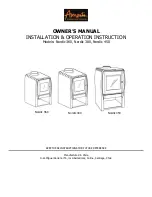
25
8390-975
Vermont Castings • Defiant® Model 1975-CAT-C Installation Manual_R8 • 02/21
The catalytic combustor creates optimum conditions for
secondary combustion. Refer back to the
"Installing or
Removing Catalyst"
section of this manual.
The catalytic element is a ceramic “honeycomb” coated
with the catalytic material. The element sits at the bottom
of the secondary combustion chamber. Smoke, gases
and particulates that are not fully combusted during the
secondary combustion process pass through the catalyst,
creating a tertiary burn. This results in higher efficiency and
lower emissions.
The catalyst will initiate combustion of smoke and particulates
at 500° - 600°F (260° - 315°C), half the temperature normally
required for unaided secondary combustion. If you followed
the startup operation steps in the previous section the stove
will be sufficiently hot to allow the combustor to work. Once
the combustor starts working, heat generated by burning
the smoke will keep it working.
To determine whether the combustor is operating, refer to
the temperature probe which shows the operating range
of the catalytic combustor. This is located on the back of
the stove and is viewed from the top.
NOTE:
It will take
several minutes after closing the bypass damper for the
temperature probe to fully adjust to the new temperature. If
the probe indicator is below the operate catalyst range, add
fuel or open the bypass damper to allow the fire to further
build before engaging the catalyst again.
If the probe indicator is above the operate catalyst range,
the catalytic combustor is running too hot and may be
damaged. In many cases, decreasing the primary air can
reduce the catalyst temperature and adding less wood with
each loading can also help if overheating is persistent. Do
not add wood to the stove if the probe reads above the
operate catalyst range.
Avoid using a full load of very dry wood in the firebox, such
as dry slab wood or wood with below 14% moisture content.
This may result in continuous very high temperatures in the
secondary combustion area and damage the combustor.
Never kindle a fire with colored paper or paper that has
colored ink or a glossy surface. Never burn treated wood,
garbage, solvents or trash. All of these may poison the
catalyst and prevent it from operating properly. Never burn
cardboard or loose paper except for kindling purposes.
Never burn coal; doing so can produce soot or large flakes
of char or fly ash that can coat the combustor and cause
smoke to spill into the room. Coal smoke can also poison
the catalyst so that it won’t operate properly.
NOTE:
The ceramic catalytic combustor is fragile and will
crack if subjected to thermal shock. Thermal shock can
occur when refueling with wet wood or closing the bypass
damper too early after refueling. Hairline cracks will not
affect the performance of the combustor, but repeated
thermal shocks can result in cells falling out, somewhat
reducing the effectiveness of the combustor.
E. Adding Fuel
The griddle lifts for convenient top-loading of logs, and is
the easiest way to add fuel, Figure 5.5.
However, the front doors open as well for adding an
occasional log to a fire.
ST521
Intrepid
loading
11/00
Figure 5.5
- Top loading is the best way to add fuel during regular
use. Front loading is useful for kindling a fire.
To open the front doors, insert the handle into the door latch
stub and turn it to the left and up, Figure 5.6.
To close them, always close the left door first. Turn the
handle in the right door to the left and up (to the open
position) and close it. Finally, push on the door as you turn
the handle to the right and down. The doors will draw in
slightly, and the handle should offer some resistance as you
turn it to the closed position.
To reduce the risk of breaking the glass, avoid striking the
glass or slamming the doors.
When you are not using the door handle, store it in the
holder behind the right front leg of the stove.
ST544
door open
11/00
Clockwise to
Open
Counterclockwise
to Close
Figure 5.6
- To open the front doors, turn the handle clockwise.
















































